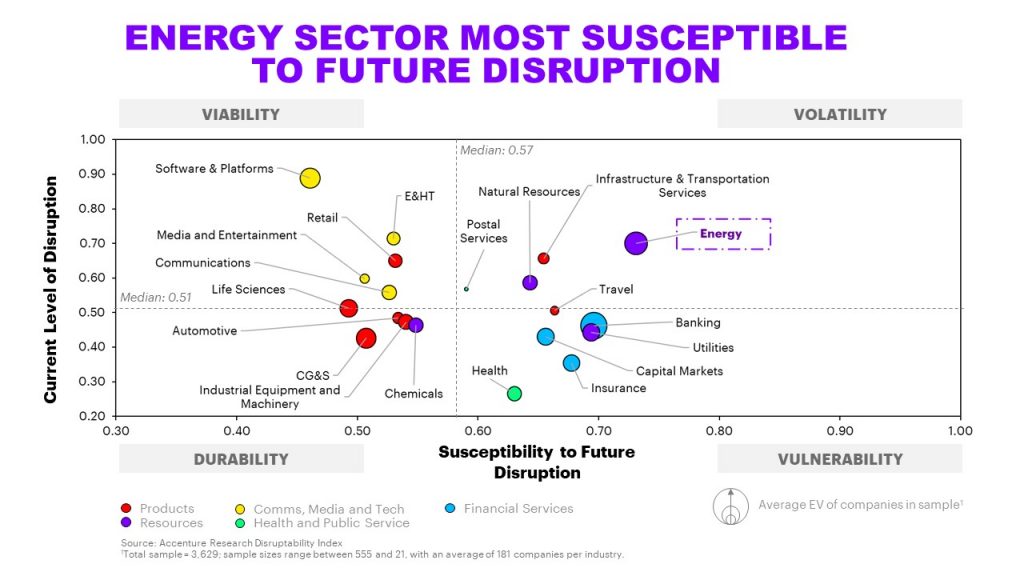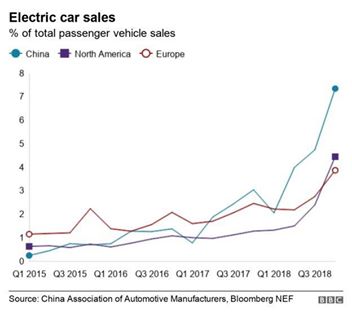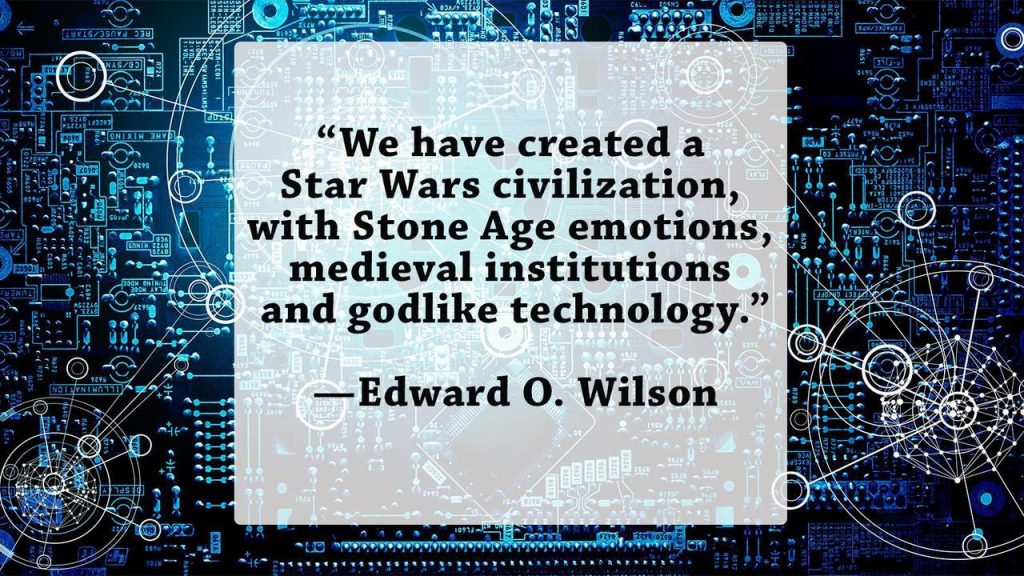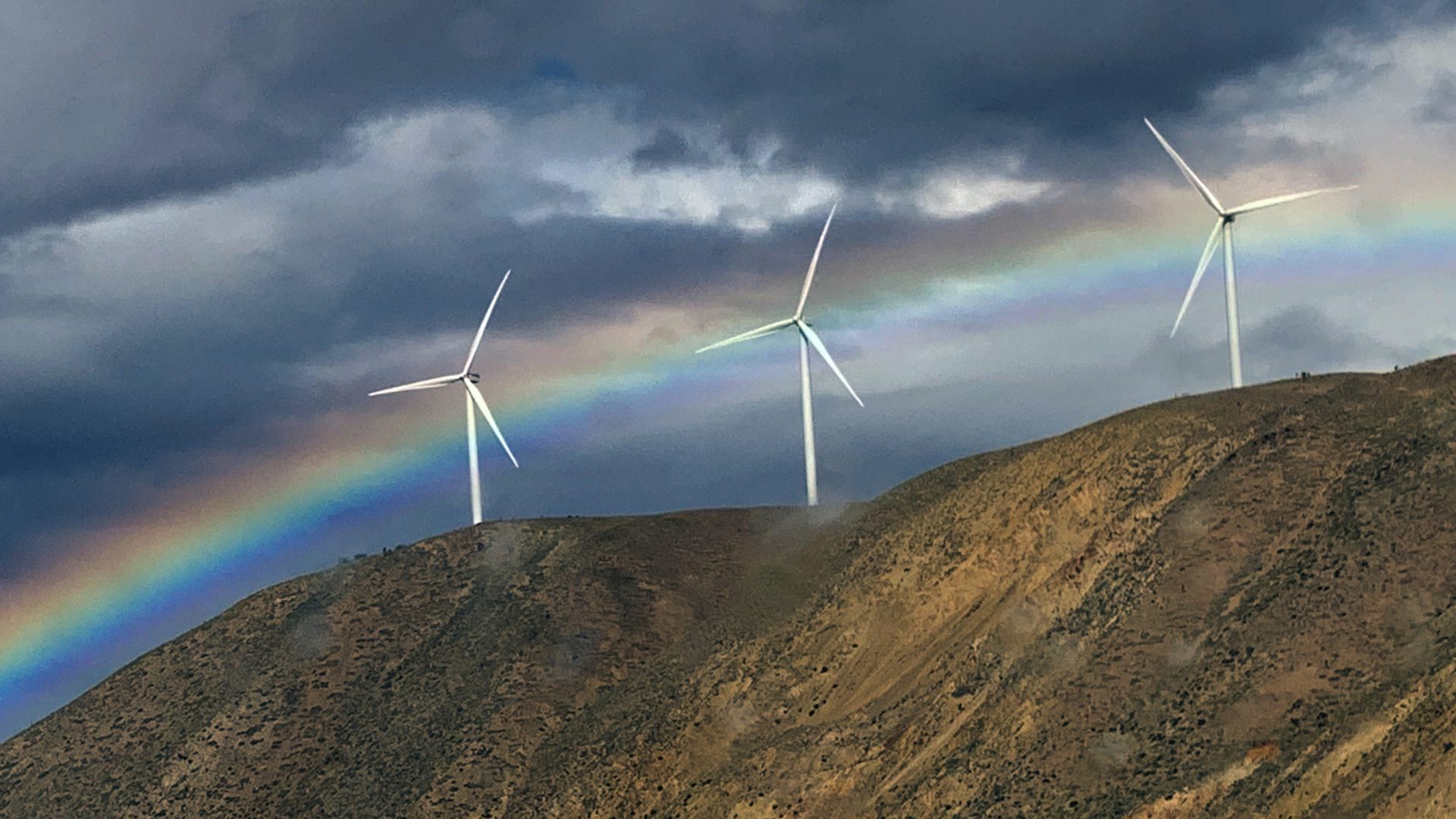“One cannot change an existing system; one must create a new system that makes the old system obsolete.” – Buckminster Fuller.
Implications of Climate Change on the Energy Sector
Energy sector analysts expect the next decade to see incredible disruption. The potential for emerging technologies to galvanize a shift away from fossil and nuclear fuels has never been greater. GreenBiz author, Nigel Topping, sums it up as follows, “the need to act on climate change is the greatest potential cause of disruption faced by new and established businesses alike, and is also the greatest catalyst for innovation for those willing to harness it.”
Scientists and researchers from many fields are proclaiming that solving the climate crisis means solving the energy crisis. This means that we need energy solutions that can crack potentially the most impossible problem humanity has ever faced. This will require precisely the type of futuristic and
In order for society to get free from dirty energy, humanity must first rise above the din of the denialism and contrarian doomism of our times. Yet we are caught in an ideological war (video) that is keeping us from the solutions that future thinkers are discussing. This is shown in the travesty that is the latest Michael Moore film, Planet of the Humans (video). This shockumentary (video) follows Trump’s own climategate hoax playbook with its populist Malthusianism and junk science.
The Energy Sector is the Most Susceptible to Disruption
Accenture is a multinational Fortune Global 500 company that provides services in strategy, consulting, digital, technology and operations. Accenture has developed a Disruptability Index to better understand the current level of disruption in the industries they serve and their susceptibility to disruption in the future. They discovered that the energy sector sits high in the volatility quadrant, where historic strengths can become areas of weaknesses. Out of 20 industries assessed, the energy sector rated as the most susceptible to future disruption (see chart):

Implications of Climate Change for the Energy Sector (Europeanclimate)
- Energy demand is increasing globally, causing greenhouse gas (GHG) emissions from the energy sector also to increase. The trend is set to continue, driven primarily by economic growth and the rising population.
- Climate change presents increasing challenges for energy production and transmission. A progressive temperature increase, an increasing number and severity of extreme weather events and changing precipitation patterns will affect energy production and delivery. The supply of fossil fuels, and thermal and hydro-power generation and transmission, will also be affected. However, adaptation options exist.
- Significant cuts in GHG emissions from energy can be achieved through a variety of measures.
- Incentivizing investment in low-carbon technologies will be a key challenge for governments and regulators to achieve carbon reduction targets. Reducing GHG emissions also brings important co-benefits such as improved health and employment, but supply-side mitigation measures also carry risks.
No one is denying the situation is very grim at this point in history. At the same time, we must also take care that being realistic doesn’t mean that we “stop being ambitious,” because “this kind of realism, applied to the climate and ecological emergencies, sends the message that we’re screwed,” says
“Spiritually and emotionally it’s not in my makeup to accept defeat, so I have a problem with this, especially before we’ve even begun the rapid transition needed to tackle the climate emergency.” – Guy Dauncey
In this article in The Tyee, “OK Doomer,” Guy Dauncey introduces us to futuristic ways of thinking about integrating smart cities, renewables, the coming disruptions, and green energy economies. He says, “taken together, walkable cities, cycling, transit, EVs, heat pumps and Passive Homes offer an 80 to 90-per-cent energy descent without a single comfortable life being wrecked. So enough with the fear mongering.”
The Edge of Disruption
Another future thinker, Tony Seba is the author of “Clean Disruption of Energy and Transportation”, “Solar Trillions” and “Winners Take All.” He is a serial Silicon Valley entrepreneur and an instructor in Entrepreneurship, Disruption and Clean Energy at Stanford’s Continuing Studies Program. Seba says we are now on the edge of disruption (video) across the energy sector with never before thought possible technologies about to enter the picture.
The new tech, says Seba, will happen for purely economic reasons in the current market system. Seba says, just ask yourself, why do businesses automate? It’s simple, they do this in order to lower their marginal costs of operation. This is the cost to produce an additional unit after the fixed costs of infrastructure. In the following video lecture, Seba introduces the new world of lost cost, clean energy disruption set to automate the future:
Further according to Seba, “overwhelming evidence points in one clear direction: the industrial age of energy and transportation will be over by 2030. Exponentially improving technologies such as solar, electric vehicles, and autonomous (self-driving) cars will transform the energy and transportation industries as we know it. This disruption is inevitable and it will be swift.
This is the clean disruption of energy and transportation” (video). We will transition into the digital autonomous era over the next decade and this will make things cheaper to produce. Renewable energy falls into this category. In October of 2020 it became official, solar is the cheapest electricity in history. As this trend permeates the value chains of our society we are rapidly approaching a new economic reality where these costs are approaching zero. That is what will drive profits today; not increased consumer buying power.
Tony Seba’s (video) predictive model is also very interesting. Seba provides a conservative estimate for how fast things are happening. We are now entering the third industrial revolution (video) giving rise to a sharing economy and the fourth industrial revolution which includes AI and autonomous vehicles. Just some of the rising stars of energy disruption now include:
- Li-on Battery Storage

- Automation
- Autonomous Vehicles
- Business Model Innovation
- EVs
- Lossless Power Transmission
- Ride Sharing
- Solar
- 3D Solar
- Hydrocel
- Geothermal
- God Parity
- Graphene
- Fusion
- Other Renewables
- Perfect Energy Storage
- Quantum Supremacy
Battery Storage
Battery storage is making headlines everywhere. In this video, Joe of Answers with Joe, discusses one of the most promising technologies in this space, the solid state battery, developed by an absolute legend in the battery world, one of the inventors of the lithium ion battery and recent Nobel Prize winner John B. Goodenough. In the following video, Joe covers liquid batteries that could power entire smart cities.
“Lossless power transmission and perfect energy storage is possible in less than a decade says physicist Ranga Dias of the University of Rochester in this interview with Quanta Magazine for their program The Year’s Biggest Breakthroughs in Physics.
God Parity
With this new battery and storage technology, energy can be stored as it’s generated, giving national renewable grid operators an instant solution for smoothing demand and bringing domestic micro-generation to hundreds of millions of people.
Also grid parity may be the least of the problems facing utilities. Now we have “god parity” – this is when the cost of electricity generation falls below that of the cost of the network. In The Guardian and for RenewEconomy, it was discussed that this means that even if the cost of coal-fired, gas-fired or nuclear generation (or, for that matter, utility-scale solar or wind) were free, it would be too expensive to compete with solar.
Further, according to Forbes Contributor, Jeff McMahon, “Los Angeles Power and Water officials have struck a deal on the largest and cheapest solar + battery-storage project in the world, at prices that leave fossil fuels in the dust and may relegate nuclear power to the dustbin.”
In a recent video series, Dave Borlace of Just Have A Think (JHAT), discusses even more huge advances in battery storage. A team at Penn State University this week published a paper detailing a revolutionary new battery management system that allows 200 miles of range to be added to a lithium ion EV Battery in just over 8 minutes.
Additionally by 2020 Electric Vehicles (EVs) are expected to begin to flood the market which will bring major disruption to the transportation sector.
“We conclude that the economics of oil for gasoline and diesel vehicles versus wind- and solar-powered EVs are now in relentless and irreversible decline, with far-reaching implications for both policymakers and the oil majors,” writes Lewis. “If all of this sounds far-fetched, then the speed with which the competitive landscape of the European utility industry has been reshaped over the last decade by the rollout of wind and solar power – and the billions of euros of fossil-fuel generation assets that this has stranded – should be a flashing red light on the oil industry’s dashboard.” – Inside EVs
Many of these innovations are making the news now. Still, the fossil and nuclear fuel oligarchs won’t be silenced and claim that the climate change and energy problem is insurmountable, even as 11,000 scientists sound the alarm. At the same time, this futuristic tech is throwing an entirely new light on these issues and showing us possibilities for a future we have not yet begun to imagine.
This film, “New Ideas New Inventions: Billions in Change 2,” shows how simple life-changing inventions provide clean water, electricity, and improve lives, especially in third world nations.
The Innovation S-Curve of Rapid Adoption
Most of the current experts doing predictions are basing them upon a linear adoption of these technologies by the marketplace. However, no successful technology in history has ever exhibited a linear adoption since the Gutenberg printing press. It has always happened on an exponential S-curve of rapid adoption. Once they hit 2-5% of the marketplace they can quickly overtake incumbent technologies in a few years, months or even weeks.
In this video, Tony Seba shares his mathematical genius and some secrets on how to do predictive analysis on exponential socioeconomic transitions when it comes to disruption factors and unexpected and rapid adoption of never-before-seen technologies.
Calculating Costs
Cost is a critical factor when determining whether an energy storage application makes economic sense. At ESS Inc., their mission is to bring to market the cleanest, lowest-cost long-duration energy storage systems. They are a catalyst for a sustainable energy future. Use the ESS Inc. LCOS formula to learn how the pros lower energy storage costs.
Historically, alternatives have faced significant enemies and barriers because they actually costed less. Successful companies approach this threat as a potential opportunity. Ultimately, switching to a resource-based demonetized society will be the only viable way to truly address this issue. In fact, it is quite clear that demonetizing is necessary in order to save the biosphere and all life in it from limitless growth economy. The new tech and renewables have already been significantly impeded by imposters in the nuclear and fossil fuel industries pandling outdated and deadly solutions that cost us all and the Earth much more than we should have ever been willing to pay.
“There are two sides to every story” says energy sector analyst, Dave Froman. He goes on to say that “the story of our transition into the digital autonomous era will be two fold as well. The majority will no longer be required in the production and delivery of most goods and services, but the other side of the coin is that everything just keeps getting cleaner and cleaner and cheaper and cheaper to produce.” This could dismantle business as usual (BAU) (video).
Furthermore, in twenty years when Artificial Intelligence (AI) and automation (video) have removed 90% of the workforce as projected by Amazon, Tesla, and other energy sector giants, outdated technologies and the workforce that has sustained them will be made obsolete. This is why Andrew Yang (video), Rutger Bregman, Elon Musk (video) and others are now calling for a universal basic income (UBI).
Ultimately, as theorists such as Jacque Fresco have argued, the secret to getting off ‘BS growth‘ is moving to a demonetized civilization (video). Others have long stood for anarcho-syndacalism as an alternative to relentlessly exploitative limitless growth paradigms. According to these scholars, adopting alternatives is the only intelligent means by which to deal with the dark side of human behavior as it relates to greed when it is shaped by a predatory monetary system. It would also allow us to restore dignity, equality, and humanity while at the same time conserving nature and all other life in the biosphere.
Open Source Systems (OSS)
How would it work if technology development was demonetized? Wouldn’t all the workers and developers on these projects just quit and go home? Not so. Examples abound of projects in which humans come together without mercenary rewards to create incredible systems and participate in the most profound human endeavors. One example of this is open source development.
What does “open source” mean? When a project is open source, that means anybody can view, use, modify, and distribute your project for any purpose. These permissions are enforced through an open source license. Open source is powerful because it lowers the barriers to adoption, allowing ideas to spread quickly.
Star Wars Civilization, Stone Aged Emotions
We are linear thinking mammals living in an age of exponential acceleration. The next decade is going to wreak havoc on our socioeconomic system more than the arrival of the first industrial revolution was which was responsible for the collapse of the feudal system that preceded it. He says we are now entering into the third and fourth industrial revolutions. We stand on the precipice of a technological revolution that will fundamentally alter the way we live, work, and relate to one another. In its scale, scope, and complexity, this transformation will be unlike anything humankind has experienced before.
Very often, our stone age brains simply cannot keep up with this new math. The eminent biologist, Edward O. Wilson, argues in a controversial new book The Social Conquest of Earth that our Stone Age emotions are still at war with our high-tech sophistication.

A Cautionary Tale
Things are changing faster now than anytime before in history. As exciting and promising as this is, we must ensure that these techno-fix solutions are truly resource based and sustainable. Further John Zerzan, a unique primitivist philosopher, has made very strong arguments that we should heed strong caution on the techno-fix conundrum and he has some valid points that we must heed. Zerzan, who is entirely anti-technology, discusses the murderous technology of the future (video). Other critics of “technofix” solutions have said that the only sustainable level of technology is the Stone Age.
Historically, technology has been heavily rebuked in the environmental movement for having gotten us into the climate crisis in the first place. It is often said that these techno-fantasy solutions could worsen our current condition. Many warn that the only green energy is less energy. A “green tech utopia” built on new “sacrifice zones” – often located in the global south and harming indigenous people – to mine all the minerals required by the “green technology” is wrong and won’t work. This is not entirely untrue. And this is a cautionary tale.
Futuristic technology solutions have in the past fallen into the trap of becoming part of greenwashing and green growth campaigns within the current business as usual setup which relies on a systemically flawed fiat monetary system. Technology developers must know that new tech cannot solve the issue of sustainability if is inherently invested in infinite growth, mass production, and over-consumption. In short, we need a ‘revolution of nothing‘ that leads us to adopt new and advanced technology while still getting off growth. This could present a real paradox if we are not very careful going forward to adopt minimally invasive, sustainable and regenerative solutions as a global society.
Not only that, according to Resilience.org, some of this technology has the potential to distract “from the hard but necessary work of changing the energy system now. Given the risks presented by climate breakdown above 1.5℃ of global heating – possibly just a decade or two away – we cannot afford to back future visions that do not prioritize immediate and large-scale cuts in greenhouse gas emissions.”
The importance of clean energy technology and resource based (video) technology development cannot be underscored enough. This will become a larger question for human civilization going forward as to which of these technologies is really necessary and how they can be made truly sustainable while avoiding the pratfalls of ecomodernism and accelerationism.
Yet, the notion that technology will not impact our future in increasingly valuable and life saving ways is also extremely perilous. We need technology to be better, and knowing that, we have come to rely on it in ways never before thought possible. We simply cannot put the genie back in the bottle.
In so many ways the disruptive energy movement is called upon to do the impossible and on top of that, it must also be sustainable, possibly even self-regenerative, biophilic, and ecologically ethical. It must also somehow reduce our carbon footprint. All of this presents paradoxical challenges that simply do not work given our current socioeconomic system (neoliberalism) and the likelihood that decoupling or accelerated post-capitalism schemes will improve upon this is naive at best.
How much sustainability this new visionary technology can achieve remains to be seen. Ultimately, constraint has always been a driver of disruptive innovation. What clearer constraint could there be than the biophysical limits of our planetary system? The physics of our planetary and ecological systems can no longer be ignored.
Still, those at the top of the technology game like Tesla Motors are already heavily investing in what they see as a clean energy future. Other future thinkers like Steve Cohen, at the University of Columbia say “the growth of the electric vehicle market provides an example of how the transition to a renewable resource based economy will probably take place, particularly if you combine it with the sharing economy.” He says these combined factors have the potential to move us into a sustainable future unlike anything we’ve seen before.
In short, we have entered a new dark age. We don’t have a lot of time (#WeDontHaveTime) considering climate lag, sea level rise, and the multitude of disasters already unfolding due to human-caused climate crisis. It is true now more than ever that, as the saying goes, necessity must be the mother of invention.
Learn more:
- Energy Disruptors
- Atomic-scale Manufacturing Now a Reality
- Dangerous Ideas with Ray Kurzweil | Singularity University
- Noam Chomsky on AI: The Singularity is Science Fiction!
- Can Business and Big Tech Really Bend Their Mighty Practices to Prevent Extinction? Explore Green Swans
- These Companies Are Embracing the Disruptive Innovation of Climate Action | GreenBiz
- Climate Change’s Great Lithium Problem
- Toyota Pushes Ahead With Solid-State Batteries for Future Electric Cars
- The Road to the Autonomous Age … | Forbes
- 2019’s 100 Most Important Interesting and Impactful People in UK Tech | Business Insider
__________________________________________________________________
References:
- Bodley, John (1997, seminal work). Victims of progress. Retrieved from https://hpsfaa.wildapricot.org/Resources/Documents/AppliedAnthropologist-1997/fall1997/A%20Critical%20Essay%20on%20John%20H.%20Bodley%E2%80%99s%20Victims%20of%20Progress.pdf
- CNBC (2019). Did we just witness the end of big oil? Retrieved from https://www.cnbc.com/2019/09/22/climate-change-did-we-just-witness-beginning-of-end-of-big-oil.html
- Cohen, Steve (2017). Tesla’s model 3 and the transition to sustainability. Retrieved from https://blogs.ei.columbia.edu/2017/07/31/teslas-model-3-and-the-transition-to-sustainability/
- Dauncey, Guy (2019). OK doomer: a ‘yes it’s possible!’ response to Bill Rees’s ‘realistic’ climate challenge. Retrieved from https://thetyee.ca/Analysis/2019/11/25/OK-Doomer-Climate-Challenge-Response/
- GNH Centre (2019). The 9 domains of GNH. Retrieved from http://www.gnhcentrebhutan.org/what-is-gnh/the-9-domains-of-gnh/
- Manning, Jeanne (2019). Hidden Energy. Book
- Scott, Joe (2017). Answers with Joe: the Venus project and the resource-based economy. Retrieved from https://www.youtube.com/watch?v=nYodgWapmgc
- Seba, Tony (2017). Edge of disruption (video). Retrieved from https://www.youtube.com/watch?v=7WwtIPeGnd4
- Saunders, Max (2019). Futurology: how a group of visionaries looked beyond the possible a century ago and predicted today’s world. Retrieved from https://theconversation.com/futurology-how-a-group-of-visionaries-looked-beyond-the-possible-a-century-ago-and-predicted-todays-world-118134?fbclid=IwAR2qqg0Y6Z8vksnpw5Y0J7FNiWVYZVKQB_U_grE6YSpiewbjz37YA56Svyw
- Tsakraklides, George (2019). The nothing manifesto: we need a revolution of nothing. Retrieved from https://medium.com/@george.gpt/the-nothing-manifesto-8c1e3061cffc
- You38.org (2019). Transfer fossil fuel subsidies onto solutions.
Retrieved from https://you.38degrees.org.uk/petitions/transfer-fossil-fuel-subsidies-onto-solution-s?just_launched=true&fbclid=IwAR3ZMr1NRYr2PdgvGb-Medru6AQhDNYl4YRXCOdfFTC3wxdTW4mvqtyeRkk - Zerzan, John (2016). The murderous idolatry of the future: anarcho-primitivism and the end of technology (video). Retrieved from https://vimeo.com/160083053?fbclid=IwAR0tPgbE8B7csGLnLnaSKUA2AL1Q6ArVAGRdHeZDax4BmJvaE14aq1YhlRk
__________________________________________________________________
Last Updated: 06/19/2021






